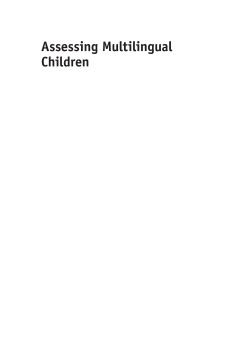
Additional Information
Book Details
Abstract
Second language learners often produce language forms resembling those of children with Specific Language Impairment (SLI). At present, professionals working in language assessment and education have only limited diagnostic instruments to distinguish language impaired migrant children from those who will eventually catch up with their monolingual peers. This book presents a comprehensive set of tools for assessing the linguistic abilities of bilingual children. It aims to disentangle effects of bilingualism from those of SLI, making use of both models of bilingualism and models of language impairment. The book’s methods-oriented focus will make it an essential handbook for practitioners who look for measures which could be adapted to a variety of languages in diverse communities, as well as academic researchers.
This landmark publication brings together various approaches to the diagnosis of language disorders in bilinguals across numerous language pairs and sociolinguistic contexts. Such comprehensive coverage is unparalleled in any previous volume on this topic. An important feature of this book is that it includes in-depth rationales for task development and extensive details about the tasks. This makes it an invaluable resource to both clinicians and researchers in the field of language development and disorders.
Johanne Paradis, University of Alberta, Canada
Armon-Lotem, de Jong, Meir and their 100+ collaborators dreamed the impossible and then accomplished their dream. Now, they’re taking the crucial step to share it freely with clinicians, teachers, parents and policy-makers concerned with understanding language impairment in the context of bilingualism. Through this book and the many articles referenced in it, we can find thoughtful advice about general principles for diagnosing two languages in one child and also practical strategies for examining the dozens of languages and hundreds of language pairs encompassed by this ground-breaking project.
Barbara Zurer Pearson, University of Massachusetts Amherst, USA
Sharon Armon-Lotem is Associate Professor in the Department of English Literature and Linguistics and a member of The Gonda Multidisciplinary Brain Research Center at Bar Ilan University, Israel.
Jan de Jong is Assistant Professor at the University of Amsterdam, the Netherlands. He is a member of the Amsterdam Center for Language and Communication.
Natalia Meir is currently working on her PhD in the Department of English Literature and Linguistics at Bar-Ilan University, Israel.
Table of Contents
| Section Title | Page | Action | Price |
|---|---|---|---|
| Contents | v | ||
| Contributors | vii | ||
| Introduction | 1 | ||
| Part 1 Syntax and Its Interfaces | 23 | ||
| 1 Elicitation Task for Subject–Verb Agreement | 25 | ||
| 2 Contrastive Elicitation Task for Testing Case Marking | 38 | ||
| 3 Elicited Production of Object Clitics | 55 | ||
| 4 Comprehension of Exhaustive Wh-Questions | 76 | ||
| 5 Sentence Repetition | 95 | ||
| Part 2 Phonological and Lexical Processing | 123 | ||
| 6 Non-Word Repetition | 125 | ||
| 7 Using Parental Report to Assess Early Lexical Production in Children Exposed to More Than One Language | 151 | ||
| 8 Designing Cross-Linguistic Lexical Tasks (CLTs) for Bilingual Preschool Children | 196 | ||
| Part 3 Beyond Modality | 241 | ||
| 9 Assessment of Narrative Abilities in Bilingual Children | 243 | ||
| 10 Executive Functions in the Assessment of Bilingual Children with Language Impairment | 277 | ||
| Part 4 From Theory to Practice | 299 | ||
| 11 Clinical Use of Parental Questionnaires in Multilingual Contexts | 301 | ||
| 12 Proposed Diagnostic Procedures for Use in Bilingual and Cross-Linguistic Contexts | 331 | ||
| Language Index | 359 | ||
| Subject Index | 361 |
